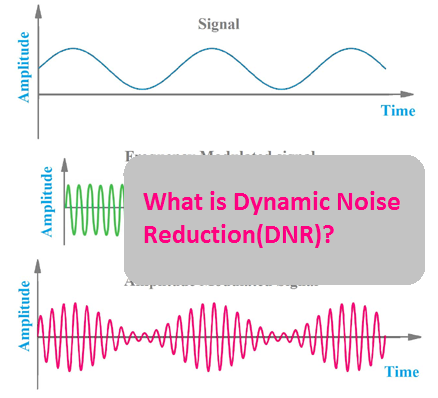What is Dynamic Noise Reduction(DNR)? Explained
Dynamic Noise Reduction or DNR is the process or system to remove noise from dynamic signals or time-varying signals such as audio signals or video signals. Previously the DNR is introduced as DNL or Dynamic Noise Limiter by Philips in 1971 to reduce noise from audio signals. After the DNL is developed into DNR that was especially used for noise reduction in long-distance telephony systems. Basically, the DNR system compares one frame to another frame of signals and it removes the tiny speaks that are not the same in frames.
It is known as Dynamic Noise Reduction because it removes the background noise from running audio or video signal. This system is mostly used with audio signals.
Now the question is why we need a dynamic noise reduction system. When the audio signals or data are stored in any medium such as an audio magnetic tape may be prone to such noise issues when it is used after a long time. And, also in a long-distance telephonic line signals are mixed with noise. So for the live broadcasting system, the dynamic noise reduction system helps a lot. In communication systems like telephony or video conferencing, DNR plays a crucial role. By suppressing background noise, it ensures that the voices of the participants are clear and intelligible. This is especially important in noisy environments or situations where there are multiple participants speaking simultaneously.
This noise reduction system can reduce noise up to 10dB. The advanced noise reduction system not only performs the frame-to-frame temporary noise reduction but also removes the spatial noise from the same frames. The DNR system does not require the encoded source material from the signal source they can work with playback signal only. This property differs it from the modern Dolby and dbx systems.
You can find the applications of DNR or Dynamic Noise Reduction System in Car Stereo sound systems, microphone recording systems, live board casting systems, etc.
The DNR system is available in the form of physical electronic circuits and software-based. The electronic circuitry can work with both analog signals and digital systems as per its design but the software-based system required digital signals. So here more steps are involved such as filtering, analog to digital converter, digital to analog converter, etc.
The DNR system is available in the form of an integrated circuit(IC) also such as IC LM1894. The IC LM 1894 works on the principle of psychoacoustic techniques for the reduction of noise signals. That is why it works very well than normal conventional circuits. It is mostly used for MP3 compression. Basilaccy what happens, it removes the part from the sound spectrum that is outside from the human hearing or human cannot fell. So the overall size of the audio data footprint is reduced. The IC LM1894 is very different from the normal active and passive filter circuits because they just remove the noise to a certain level but they cannot change the characters of the whole signal. On the other hand, this IC can change the characteristics of the signal and compresses with noise reduction.
There are so many advantages of IC LM1894 such as it can reduce the size of the whole filtering circuit, it can operate with a wide range of voltage such as 4.5V to 18V, can reduce the no of components used in a circuit, etc.
Read Also:

